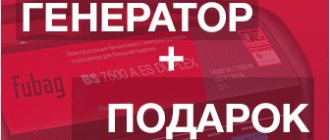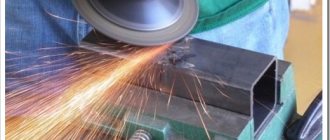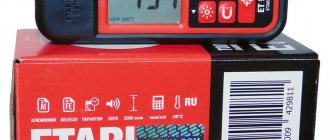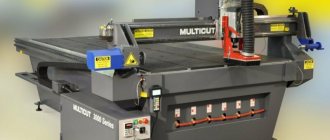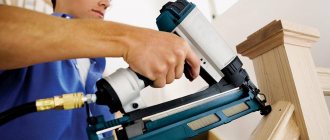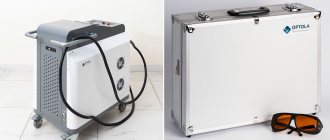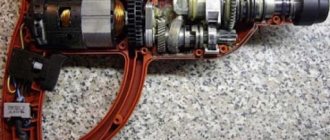Rollers and brushes are a relic of the past. Today, both professionals and amateurs choose spray guns as a painting tool. And there are reasons for this:
- Excellent work quality
- Save time
- Reduced paint consumption
Spray guns are used everywhere - from construction sites and furniture workshops to car services. Each task requires a certain type of tool, and the main thing here is not to miscalculate. How to choose a pneumatic spray gun and not make a mistake? Let's look at this issue in detail.
To be fair, we note that in addition to pneumatic ones (“powered” by air from compressors), there are also electrical devices (powered by the network). However, it is pneumatic spray guns that are more popular.
Briefly about pneumatic spray guns - operating principle
Structurally, the tool is quite simple. It consists of a gun-shaped sprayer and a working paint tank. A flexible hose is used to connect to a source of compressed air (compressor).
During operation, air is supplied along with paint, which is blown out of the nozzle, dispersing into tiny particles. The paint flow has a certain shape (torch), which depends on the spraying technology.
Spray gun for mastic
Anti-corrosion treatment of a car and other metal structures is very important and in the long term pays off with the service life of the element.
Mastic, mowing and anti-gravel compounds can also be applied with a brush, but fortunately, there is a simple, specialized pneumatic gun for this task. The spray gun for mastic and anticorrosion is a simple design with a handle, trigger and nozzle. Most models are not equipped with a native cylinder, but only have a mount for a Euro can, which is a consumable material and is disposed of when the mixture runs out. There are models with a factory red cylinder, but they are intended mainly for pressure washing.
article from the Rating section
- 80
Power tools Pneumatic tools Painting tools
Save this page on your social media. network and return to it at any time.
ADD A COMMENT
The best pneumatic spray gun using spray technology
Existing pneumatic spray guns have one of three spray technologies:
- HP (from English high pressure - high pressure)
- HVLP (from the English high volume low pressure - large volume at low pressure)
- LVLP (from the English low volume low pressure - small volume, at low pressure)
These abbreviations are present in the model names.
Now be extremely careful. Each technology has its pros and cons.
HP pneumatic spray guns.
The devices are characterized by high outlet pressure, which can reach up to 1.5 atm. This feature leads to high air consumption. However, the resulting plume is quite wide. It allows you to quickly and evenly apply paint.
Advantages:
- Painting takes little time
- Excellent spray quality
- Uniform colorful torch
Flaws:
- High air consumption - a powerful compressor is required
- High blood pressure requires specific handling skills
- Up to 60% of the paint goes into the “color mist”
- High air pollution requires the use of protective equipment
Pneumatic HVLP spray guns.
The design reduces outlet pressure. This reduces the rate at which paint particles are sprayed and allows for a denser application. Low pressure allows you to keep the gun closer to the surface, which reduces air consumption and pollution.
Advantages:
- Savings – up to 30% of paint is lost.
- Good quality coating
.Flaws:
- High cost relative to HP models
- High air flow - also requires a powerful compressor in tandem
The price of such an instrument is not a barrier to purchase. Paint savings of up to 20% allow the spray gun to quickly pay for itself, making it a better choice for many. Pneumatic Spray Guns LVLP.
The technology is considered the most advanced today. Atomization requires a minimum amount of air inlet. Pneumatic tools of this type are resistant to pressure changes in the compressor. In terms of consumption, LVLP transfers more than 70% of the paint. They are also used close to the surface.
Advantages
- Minimum loss value - up to 20% of paint
- Good quality coating
- Resistant to pressure changes
- Low air consumption
Flaws:
- High price
- Requires work skill
Let's summarize the above.
The HP model is beginner-friendly. A pneumatic spray gun will quickly cover a large surface, but more paint will be wasted and polishing will be required due to dispersion. The quality of the coating does not matter, but is the paint inexpensive? Choose HP with confidence.
The LVLP air spray gun is often chosen by experienced car service technicians due to savings, the possibility of applying paint close up and the absence of the need for polishing, which is not uncommon.
Speaking about HLVP, we note that such pneumatic devices are something between HP and LVLP.
Varieties
Due to the narrow specialization and certain exoticism of the miniature spray gun, it is quite difficult to find it on the shelves of general construction stores. Varieties of this tool can be found at specialized points of sale of tools for body repair or finishing materials. A small spray gun can have either an original, classic look in reduced proportions or a more specific one (airbrush). We will describe in detail the features of each type of these nozzles below.
Mini spray gun
Compact and fairly efficient pneumatic sprayer for paint and varnish materials and low-viscosity liquids. It is a smaller analogue of a standard spray gun, with all possible settings (air supply, material and torch size). The total weight of the device with an empty tank is no more than 450 grams.
A small spray bottle for painting is equipped with a proportionate tank, the volume of which does not exceed 200 ml. The container can be made of polished metal or plastic. Depending on the model, the tool can be equipped with one or more nozzles of different diameters (from 0.3 to 1.2 mm). The body and mechanism of the professional segment mini-spray gun is made of stainless steel. Budget models are made from cheaper metals and often have plastic handles.
Airbrush
A specialized pneumatic device for spraying fine paint. It has very modest sizes and shapes. Capable of drawing the smallest patterns and lines, with a thickness of 0.3 mm. It operates from a small pressure of compressed air, which is why it is called an “air brush”. It is considered the optimal tool for creativity and performing delicate, jewelry tasks of coloring small objects.
It is important to know the diameter of the nozzle (nozzle) of the spray gun
As you may have realized, spray technology is not the only thing to consider.
This pneumatic tool has such a parameter as the diameter of the nozzle (nozzle). It must match the density of the material to be applied. Everything is simple here - use the table:
| Nozzle diameter | Application material |
| 1,7-2,0 | Putty, thick materials |
| 1,5-1,7 | Acrylic primer coatings |
| 1,4-1,5 | Acrylic paints/varnishes |
| 1,2-1,3 | Base coats, metallic paints |
Spray guns can be either with monolithic tips or with replaceable nozzles.
For household needs, nozzles with 1.5 mm nozzles are the most popular - they are suitable for almost all types of paint coatings and provide good speed and quality of painting.
Small spray gun for painting a car with your own hands
Painting a car with a small spray gun is more convenient if you need to update individual parts. To make a small spray gun for painting a car with your own hands, you need to take:
- Blow gun.
- Paint container.
- Helium pen refill.
- Cap.
- Hose.
- Metal clamp.
- Canister.
- A wooden plank.
- Pump.
- Camera nipple.
Step-by-step instructions for making mini-spray guns for painting cars at home with your own hands:
Spray gun tank – Upper or Lower, Plastic or Metal
The location of the tank does not significantly affect the operation of the pneumatic painting apparatus.
The option with a lower tank is chosen by those who find it more convenient to work this way. It can be placed on a surface, and it does not block the view of the master. As for the top one, it uses every last drop of paint. Based on the material, spray guns with plastic tanks are more often in demand. They are suitable for water-based and acrylic paints, are lighter than metal and help keep track of residue inside.
Now, pay attention! Metallic options are required for solvent based paints. They are heavier, but here the choice is determined by necessity. It's worth remembering.
The volume of the tank is chosen at your discretion. Some people will like to work longer without updating the paint, while others will decide that the heavy weight will become a hindrance in their work.
Spray gun for applying glue
The connection of all kinds of materials over a large area requires a very uniform adhesive layer. Typically, a glue spray gun is used in the furniture industry to reliably connect foam rubber to wood, leather, fabric and other materials. For such tasks, the most optimal is a pneumatic spray gun with an upper tank, capable of creating the most even layer of adhesive. The range of suitable models and prices varies significantly, but for household and semi-professional work almost any gun with a 1.7 mm nozzle is suitable.
When choosing a pneumatic spray gun for applying glue, it is recommended to consider models with an LVLP (Low Volume, Low Pressure) spray system, which has the least fogging during operation and the greatest transfer of material to the surface. Make sure the nozzle and needle are made of brass or steel to resist corrosion. If models with a stationary compressor are not suitable, you can consider an electric spray gun with a remote compressor. It is desirable that the pistol body be made of metal, like the next model.
Selecting a compressor for a spray gun based on performance and receiver volume
And, of course, the capabilities of your compressor should be enough to power the spray gun.
Working with a weak compressor will affect the quality of the paint - in the form of drops and smudges. Let us recall the basic formula for matching a compressor and a pneumatic tool: the compressor output output should be 20 percent greater than the average air consumption of the spray gun.
Example.
For a MASTER G 600 spray gun with an air flow rate of 198 l/min, you need a compressor with an output capacity of 198 l/min + 20% = 238 l/min. Since the manufacturer usually specifies the input capacity, a reduction factor must be applied. For a belt compressor it is 0.75, for a coaxial compressor it is 0.65. That is, we need a coaxial compressor 238/0.65 = 366 l/min or a belt compressor 317 l/min.
As for the volume of the receiver, 24-50 liters is the golden mean between compactness and frequency of activation during continuous operation. This is quite enough even for professional repairmen.
Is it possible to paint a car efficiently with a mini spray gun?
With local repairs, you can do it yourself and not take the car to a service center. To work on surfaces in detail, you need mini spray guns for painting cars.
Body painting
With low air consumption and cost-effectiveness of the sprayed material, mini-models look advantageous against the background of their larger counterparts that form a foggy cloud. When applying metallic paint, the artist can adjust the spot size and spray level, which will allow for a high-quality application of a new coat of paint even in narrow spaces.
And some more tips:
- For convenience and more delicate work, choose spray guns equipped with adjustments - air flow, paint flow, and torch shape. For example, adjusting the spray pattern on your paint sprayer will help achieve wider coverage.
- Working with a paint sprayer requires careful cleaning of the air leaving the compressor from oil, which will inevitably be in it. If your compressor is not oil-free, you need to take care of cleaning the air from oil - install a filter at the outlet
Having replenished your knowledge base, you can safely go for a spray gun. To consolidate, better understand and remember, we recommend that you watch a specially prepared video that will help you determine which spray gun is better:
How to choose a small spray gun for painting a car
To prevent painting a car from turning into torture, you need to choose a spray gun based on the following parameters:
- Humidity of the room in which work will be carried out. If the humidity is high, you should choose a mini spray gun with a pneumatic system for painting a car. The torch of the device is even, the area depends on the diameter of the nozzle. Even with high humidity, the device is safe, while an electrical device, heating up and producing sparks, will pose a threat to the health of the master. If you plan to carry out repairs in a dry room, you can purchase a powered tool.
- Productivity depends on the ability to change nozzles, so it is better to buy a kit with a set of different diameters.
- Torch width. In the specifications, the manufacturer always indicates the minimum and maximum spray width.
- The amount of pressure. This parameter is important. After all, at high pressure there is a large release of paint material, at low pressure the surface to be coated becomes rough.
- Torch shape. Flat - leads to an increase in air flow and is needed for working with a large surface. Round – more effective when painting small elements.
- Tank volume. Average capacity - 0.6-0.8 liters.
Buyers should choose models from well-known brands. Manufacturers with leading positions in the market guarantee the quality of the product and provide a warranty on the equipment.
Paint sprayers for professional use
The HVLP air spray gun is characterized by high volume and low pressure. Such pistols were created in the late 80s of the last century. Their purpose is to protect the environment.
The air channel of the device has a special structure, which is why paint is sprayed like this: at the outlet there is a low pressure, almost 0.7 atm, and at the inlet there is a high pressure, approximately 3 atm. Therefore, the material transfer is 70%. The rest is lost in the air.
In addition, the HVLP spray gun at the outlet has a low speed of paint or varnish.
This property is an advantage of this model, since there is a saving of material at the output.
In this case, a small foggy cloud is formed, but the composition must be sprayed at a close distance from the surface to be treated - no more than 15 cm. This is the main difference between the HVLP sprayer and the LVLP spray gun.
Before buying this pneumatic sprayer for car painting, it is necessary to familiarize the user with the advantages and disadvantages of the device.
Advantages of HVLP paint sprayer:
- High savings in paint and varnish. Almost 70% reaches the surface.
- High performance.
- Does not harm the environment, the formation of a small foggy cloud.
- Doesn't leave any trash.
Disadvantages of the spray gun:
- High air consumption (over 360 l/min). Because of this, powerful and efficient compressor equipment is needed.
- Large diameter air duct.
- Using an air filter. When the compressor operates, water and oil inclusions enter.
- Inconvenient when applied to hard to reach areas. The distance to the surface to be treated is no more than 15 cm.
- Required level of knowledge of a painter. If the application of the material is delayed, drips and layers may occur.
What is the difference between a spray gun and a paint gun?
A spray gun is for a professional painter what a scalpel is for a surgeon, the most important tool without which the desired result cannot be achieved. They work thanks to compressed air, which sprays small droplets of paint under pressure - this is to briefly describe the principle of operation, but on the market you will find a huge variety of devices that differ in both functionality and spraying features.
Externally, almost all paint sprayers are similar; a beginner is unlikely to distinguish a spray gun for water-based paint from an apparatus for paints and varnishes. The differences lie inside, in the structure of the air nozzles, in the design of the internal channels through which air passes. These features affect both the speed of task completion and ease of use. We touched on the topic of the device’s design, let’s look at it in more detail.
An electric spray gun (as it is called because it is powered by a compressor connected to the network) consists of a housing, a pump, a hose, a mixture flow regulator, a tank, a trigger and a switch button - such a description will make you think that this is an ordinary paint gun. . But what makes a spray gun a spray gun are those very nuances, for example, the air supply regulator, which serves to fine-tune the outlet pressure. Professional tools are equipped with a regulator for the shape of the “torch” – the output paint jet. The nozzle opening regulator controls the amount of paint supplied.
